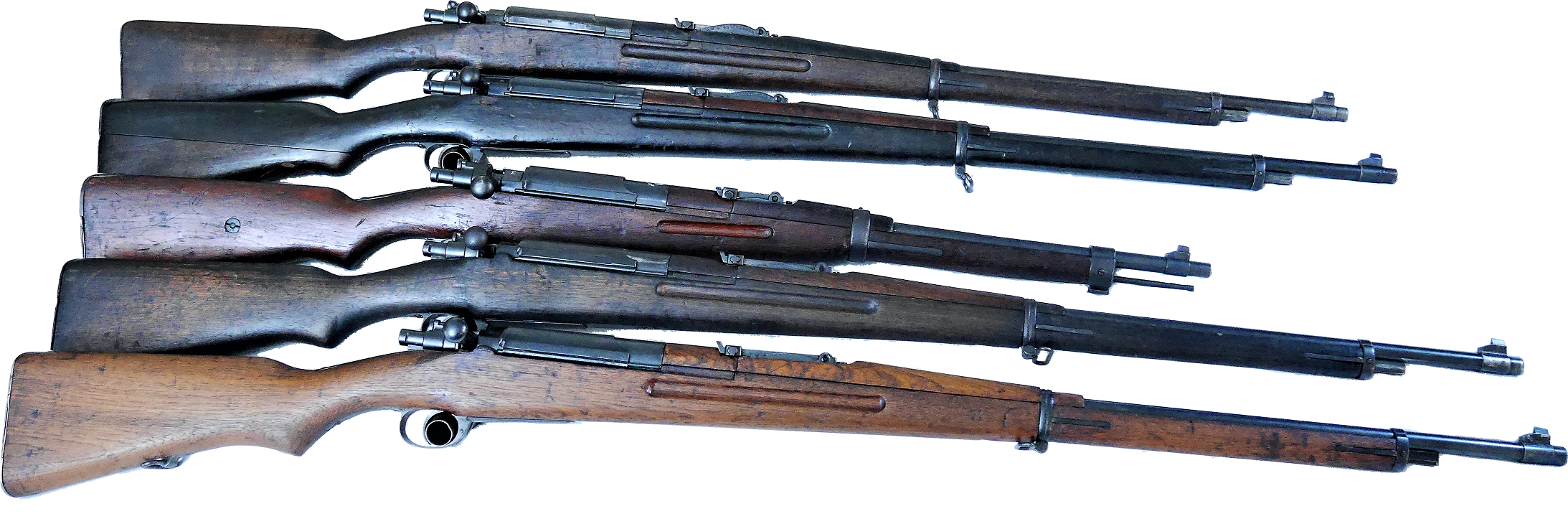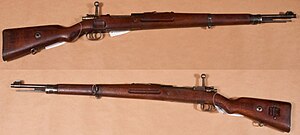Introduction to, and Identification of, The Siamese Mauser
- Content, Text, User Submitted, Written Articles
- by SpacecowboyfromNJ
- April 6, 2020
Post Views: 8,061

This guide will hopefully be able to provide you with a good base of understanding of the basics of the Siamese Mausers. This guide is certainly not all-inclusive and there is likely going to be oddities in Siamese Mauser variants that don’t exactly match up. As Thailand has not produced much in the way of documentation, most of what is currently known about Siamese Mausers comes from the direct observations of collectors. However, since the group dedicated to collecting them is so small, it is relatively easy for rare examples to be completely unknown to the dedicated collectors. If you come across any Siamese or Thai firearm you think maybe an abnormal example please let me know so I can document it and pass that information on to other collectors.
Siam (modern day Thailand, which I’ll refer to interchangeably depending on context) in the 1800’s found itself in some rather unique circumstances. While the European Colonial powers were claiming all the territory in Asia that they could, Siam was left to exist on its own. This wasn’t due to them being inaccessible or being militarily strong enough to resist, but rather a quirk of luck. The British had claimed the territory to the west of the Kingdom of Siam while the French claimed the territory to the east. Both countries, which historically didn’t always get along, mutually decided to leave the Kingdom of Siam to its own autonomy as a buffer zone between their territories. The King of Siam, Chulalongkorn (also known as King Rama V), knew that the existence of his Kingdom was tenuous at best, and reliant completely on the powerful European countries allowing them to be. In order to ensure the Kingdom’s continued existence, he initiated plans to rapidly modernize Siam in hopes of being recognized in the eyes of the European powers as a legitimate modern civilized country with the same standing as any European country. Part of those efforts was a modernization of the military.
In pursuit of modernizing its military, Siam began looking for a modern rifle to equip its infantry. Due to Siam being in a unique position they wound up developing, though not a completely new rifle, a very unique twist on one of the best designs in the world at the time. Despite the uniqueness of their firearms, they are often overlooked by collectors. Thailand didn’t keep the best records on their firearms so a lot of what is known about them is based on observations of examples that have been found on the collector’s market. Unfortunately as a result of lacking easy access to data on Siamese/Thai firearms there has been a lot of outdated (and some downright false) information being passed around about these rifles. If you have ever had an interest in, or are just plain curious about the Siamese Mauser this should give you a pretty good overview of the basics to help you on your way to discovering this unique take on the Mauser.
The Type 45 Rifle
Type 45 Rifle
Siam began searching for a new rifle in the early 1900’s. After looking at the various existing Mauser designs, they selected the various features they had liked best in a Mauser rifle as well as including the dust cover design from the Japanese Type 35. While Siam would have liked Mauser to have built the rifle design they came up with, Mauser at the time had its plate full with large contracts for both Germany and Turkey. Looking for an alternative manufacturer, Siam found that the Imperial Japanese Army Tokyo Arsenal was willing to take up the manufacturing of this new rifle. Siam officially adopted this new rifle late in the 121st year of the Rattanakosin Era (early 1903) and thus was designated as the R.S. 121. Siam contracted with the Imperial Japanese Army Tokyo Arsenal for an initial order of 20,000 rifles (serial numbers 1-20,000), and later ordered an additional 20,000 rifles.
The Type 46 Rifle
Type 46 Rifle
When Siam contracted the second batch of 20,000 rifles (serial numbers 20,001-40,000) there were some slight changes made to the design.* These changes were made due to the Japanese-sourced wood having an inherent weakness that could lead to the stock splitting. Despite these changes, the rifles were still designated as the R.S. 121 like the previous batch and marked as such. When Siam moved to the new calendar however they decided to apply a new designation to the rifles with these changes to denote that these rifles have differences from the original Type 45 pattern. The designation Type 46 however applies to more than just the rifles from this second contract. As Type 45 rifles were damaged it was common to rebuild them to the newer Type 46 pattern, so they too are designated as Type 46 rifles.
The Type 46 rifles had 4 main differences between them and the Type 45. To deal with the weaker nature of the wood available in Japan, they changed from a stock made from a single piece of wood to one made from two pieces like those found on the Japanese Arisakas.
The Type 47 Carbine
(No Picture of original Type 47 carbine available)
In 1904 Siam contracted with the Imperial Japanese Army Tokyo Arsenal to build 10,000 carbine (serial numbers 1-10,000) versions of the R.S. 121. Due to Thai not having a native word for carbine at the time, these rifles were classified as short rifles and designated as the R.S. 123. Note the seeming two year difference between R.S. 121 and R.S. 123 even though they were manufactured in 1903 and 1904, respectively. This is a result of the original Siamese calendar starting in April instead of January like the modern Gregorian calendar. When Siam moved to the new Buddhist calendar these rifles were re-designated as the Type 47 in conjunction with the year they were adopted, 2447. These carbines share most of the same features of the Type 46 rifles, though with a shorter 20.25” barrel. Other noticeable differences include the magazine floor plate release button being moved from the trigger guard to just in front of the floor plate,
The Type 47/66 Carbine
Type 47/66 carbine. Image provided for article by Francis C. Allan
With the introduction of a newer cartridge, Siam began modifying the Type 47 rifles for use with the new cartridge. This involved two main changes: reaming out the chamber slightly so the new cartridge could be chambered and grinding down the rear sight ramp to match the ballistic trajectory of the new round.
Type 47/66 Bayonet lug
In addition to the original contract of Type 47’s that received the upgrade, in the mid to late 1930’s Siam manufactured an approximate additional 3000 Type 47/66 (serial numbers ~10,000-~13,000) in the Bangkok arsenal using the original tooling they had received from the Imperial Japanese Army Tokyo Arsenal. These were brand new manufactured and not made by simply cutting down existing Type 45/Type 46’s
Type 47/66 Built by the Bangkok arsenal
It has been noted that there are a few “Type 47/66’s” that seem to have been made from cut down Type 45’s and Type 46’s, but as of now there is no evidence that these were made by Siam and it is believed they were gunsmith projects after having been imported.
The Type 45/66 Rifle
Type 45/66 Rifle
Like with the Type 47/66, Siam also began upgrading the rest of their stock pile of rifles for the new cartridge. Within that stockpile were Type 45’s that had not been upgraded to the Type 46 pattern. If the rifles didn’t have any outstanding issues they were left in the Type 45 configuration and just upgraded to take the new cartridge.
Type 45/66
These rifles are often referred to with the designation of Type 45/66 by collectors. The reason for noting that the Type 45/66 is specifically a designation used by collectors is that currently there is no solid evidence that Siam’s military having used a unique designation for this configuration. Collectors find this designation useful as it conveys what variation it is, and it aligns with the designation of Type 47/66 (which was a designation that was definitely used by the Siamese military). Like the Type 47/66, this process involved reaming out the chamber slightly and grinding down the rear sight ramp to match the trajectory of the new cartridge. This modification is easy to spot as originally there were distance markings on the side of the ramp, and those markings were half cut off during the process.
Type 45/66 rear sight ground down
The Type 46/66 Rifle
Type 46/66 Rifle
Just like the Type 45’s, Type 46’s were also upgraded to the new cartridge. These rifles are referred to by collectors as Type 46/66’s, and like with the Type 45/66 this is a collectors’ designation that is not known to have been used by the Siamese military.
Type 46/66 Rifle
Again, like the Type 45/66’s the modification of Type 46’s to Type 46/66’s involved reaming out the chamber slightly and grinding down the rear sight ramp. This modification can also easily be spotted by the markings on the side of the ramp being half ground off like on the Type 45/66’s.
Type 46/66 rear sight ground down
The Type 66 Rifle
Type 66 Rifle, Image provided for article by Francis C. Allan
As an additional note, the designation Type 66 is not a correct designation for any of the Siamese Mauser variants and is rather an Arisaka based rifle, which is outside the scope of this article.
just why? i am not really looking forward to grinding another 20 mauser variants…
Polish
Model 98a carbine

Karabinek wz.29

Karabinek wz. 1898
Checkoslavakia
Puška vz. 33 (aka vz. 16/33)

Vz. 24

Vz. 98/22
just add the classic gewehr 98 to the tech tree, no sniper scope, no trench mag, and thats it, im happy
already enough mauser variants in this game
Single shot Mauser 1871 pls












